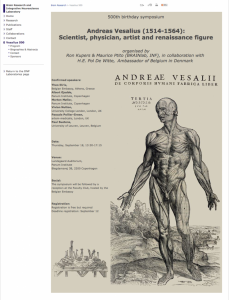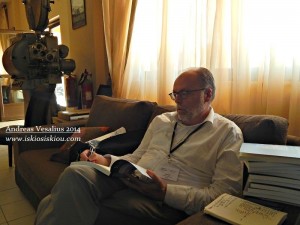Blog
“Andreas Vesalius (Brussels 1514 – Zakynthos 1564): a prodigious life, a tragic demise” by Theo Dirix
In the “Andreas Vesalius 500 Birthday Symposium” entitled “Anatomy, Art and the Body”, that took place in Copenhagen, at 18th of September 2014, numerous distinguished Vesalius scholars gave fascinating talks about the Life and Death of the great Flemish physician and artist, Andreas Vesalius.
The Symposium was organized by Prof. Ron Kupers (BRAINlab) & Prof. Maurice Ptito (BRAINlab), under the Auspices of the Belgian Embassy.
For more info and details about the program, click HERE
Among the talks of this Symposium in Copenhagen, I have chosen here the one of Theo Dirix, Consul, Embassy of Belgium, Athens-Greece, entitled “Brussels 1514 –Zakynthos 1564: a prodigious life, a tragic demise”. His talk during Andreas Vesalius Symposium in Copenhagen, focused towards the mysterious death of Andreas Vesalius on Zakynthos:
“Since I’ve been infected with V bug, I am on this crusade to convince a bigger audience what my mentors are repeating over and over again: Andreas Vesalius did not travel to Jerusalem under pressure of theInquisition, neither as penance nor escape: he went there as a devout pilgrim with the support of his employer. Upon his return, he did not die on a deserted beach in the Ionian Sea, the only victim of a shipwreck. His used up body just let him down. Indeed, weakened by his stay in the HolyLand and by an unfortunate return journey, he died in 1564 in Zakynthos,Greece, and was buried there in the Santa Maria delle Grazie Church, now destroyed by earthquakes.”
ABSTRACTAndreas Vesalius did not travel to the Jerusalem under pressure of the Inquisition, neither as penance norescape: he went there as a devout pilgrim with the support of his employer. Upon his return, he did not die ona deserted beach in the Ionian Sea, the only victim of a shipwreck. Weakened by his stay in the Holy Land andby an unfortunate return journey, he died in 1564 in Zakynthos, Greece, and was buried there in the SantaMaria delle Grazie Church, now destroyed by earthquakes.Such a demise -can it be more tragic?- contrasts heavily with the most prodigious life he led. As anoutstanding physician, he knew exactly that in his last moments his organs were failing, one after the other. Asa high society nobleman he had imagined his death less lonely and as a world famous researcher andprominent scientific and didactic author he had pictured his last resting place not in a far-off Venetian colony,let alone that his grave would be lost after a few years. And yet, many fairy tales make us believe until todaythat it was worse.What began as a poetic quest for his lost grave, did not only evolve into an ongoing search for his last restingplace by scientists and archaeologists, with the advice and support of the éminences grises of VesaliusResearch, Omer Steeno, Maurice Biesbrouck and Theodoor Goddeeris, the quest has turned into a crusade against persistent inaccuracies and stubborn assumptions in Vesalius’s biography.Read the whole article “Andreas Vesalius Brussels 1514 – Zakynthos 1564: a prodigious life, a tragic demise” of Theo Dirix, HERE.
Totally recommended!





